八年级上学期英语教案
- 格式:doc
- 大小:25.50 KB
- 文档页数:1
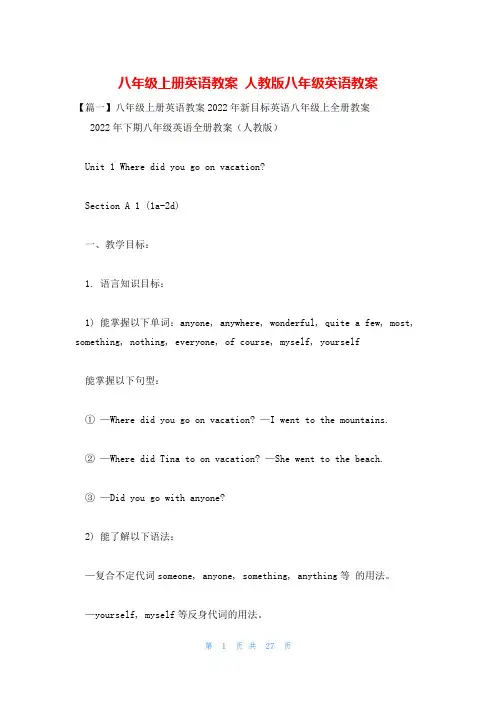
八年级上册英语教案人教版八年级英语教案【篇一】八年级上册英语教案2022年新目标英语八年级上全册教案2022年下期八年级英语全册教案(人教版)Unit 1 Where did you go on vacation?Section A 1 (1a-2d)一、教学目标:1. 语言知识目标:1) 能掌握以下单词:anyone, anywhere, wonderful, quite a few, most, something, nothing, everyone, of course, myself, yourself能掌握以下句型:① —Where did you go on vacation? —I went to the mountains.② —Where did Tina to on vacation? —She went to the beach.③ —Did you go with anyone?2) 能了解以下语法:—复合不定代词someone, anyone, something, anything等的用法。
—yourself, myself等反身代词的用法。
3)一般过去时态的特殊疑问句,一般疑问句及其肯定、否定回答。
2. 情感态度价值观目标:学会用一般过去时进行信息交流,培养学生的环保意识,热爱大自然。
二、教学重难点1. 教学重点:1) 用所学的功能语言交流假期去了什么旅行。
2) 掌握本课时出现的新词汇。
2. 教学难点:1) 复合不定代词someone, anyone, something, anything等的用法。
2) yourself, myself等反身代词的用法。
三、教学过程Ⅰ. Lead-in1. 看动画片来进入本课时的主题谈论上周末做了些什么事情,谈论过去发生的事情。
Ⅱ. Presentation1. Show some pictures on the big screen. Let Ss read the expressions.2. Focus attention on the picture. Ask: What can you see? Say: Each picture shows —Yes, I did./No, I didn’t.something a person did in the past. Name each activity and ask students to repeat: Stayed at home, Went to mountains, went to New York City 6. Went to the beach, visited my uncle, visited museums, went to summer camp3. Now, please match each phrase with one of the pictures next to the name of the activity,point to the sample answer.4. Check the answers. Answers: 1. f 2. b 3. g 4. e5. c6. a7. d III. Listening1. Point to the picture on the screen.Say: Look at the picture A. Where did Tina go on vacation? She went to mountains. Ask: What did the person do in each picture?2. Play the recording the first time.3. Play the recording a second time.Say: There are three conversations. The people talk about what did on vacation. Listen to the recording and write numbers of the namesin the right boxes of the picture.4. Check the answers.IV.Pair work1. Point out the sample conversation. Ask two Ss to read the conversation to the class.2. Now work with a partner. Make your own conversation about the people in the picture.3. Ss work in pairs. As they talk, move around the classroom and give any help they need.4. Let some pairs act out their conversations.V. Listening1. Tell Ss they will hear a conversation about three students’ conversations. Listen for the first time and fill in the chart. Then listen again and check Yes, or No.2. Let Ss read the phrases in the chart of 2b.3. Play the recording the first time. Ss listen and fill in the chart.4. Play the recording a second time for the Ss to check “Yes, I did.” or “No, I didn’t. ”5. Check the answers with the Ss.VI. Pair work1. Let two Ss read the conversation between Grace, Kevin and Julie.2. Let Ss work in pairs and try to role-play the conversation.3. Ask some pairs to act out their conversations.VII. Role-play1. First let Ss read the conversation and match the people and places they went.2. Let Ss act out the conversations in pairs.3. Some explanations in 2d.Homework:用英语询问你的一位好朋友,她(他)假期去了哪里?看到了什么?并将此对话写在作业上。
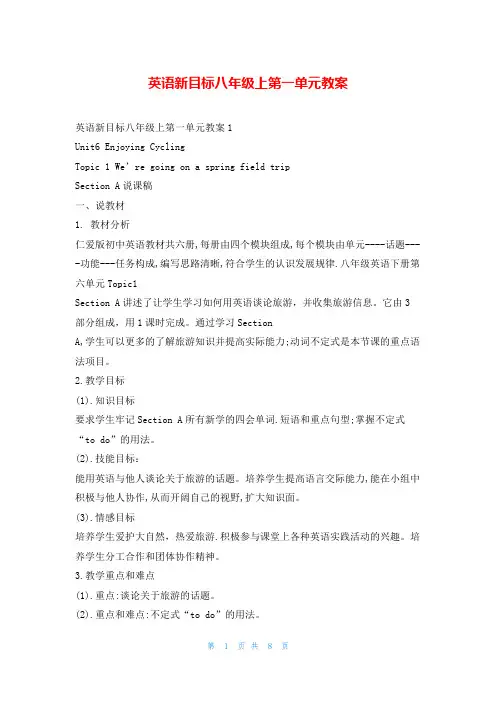
英语新目标八年级上第一单元教案英语新目标八年级上第一单元教案1Unit6 Enjoying CyclingTopic 1 We’re going on a spring field tripSection A说课稿一、说教材1. 教材分析仁爱版初中英语教材共六册,每册由四个模块组成,每个模块由单元----话题----功能---任务构成,编写思路清晰,符合学生的认识发展规律.八年级英语下册第六单元Topic1Section A讲述了让学生学习如何用英语谈论旅游,并收集旅游信息。
它由3部分组成,用1课时完成。
通过学习SectionA,学生可以更多的了解旅游知识并提高实际能力;动词不定式是本节课的重点语法项目。
2.教学目标(1).知识目标要求学生牢记Section A所有新学的四会单词.短语和重点句型;掌握不定式“to do”的用法。
(2).技能目标:能用英语与他人谈论关于旅游的话题。
培养学生提高语言交际能力,能在小组中积极与他人协作,从而开阔自己的视野,扩大知识面。
(3).情感目标培养学生爱护大自然,热爱旅游.积极参与课堂上各种英语实践活动的兴趣。
培养学生分工合作和团体协作精神。
3.教学重点和难点(1).重点:谈论关于旅游的话题。
(2).重点和难点:不定式“to do”的用法。
二.说学情1.学生对旅游较感兴趣,但对旅游知识了解较少。
2.学生的词汇量掌握不多。
3. 学生平时较少用英语与他人交谈并表达信息.。
三.说教法学法按照课程改革的要求,遵循“老师由主演变导演,学生由配角变主角”的角色转换,采用把课堂交给学生的教学理论,我运用自由讨论.分组工作.结对练习.问答练习等方法,借助多媒体、录音机,图片等教学手段,设置特定的语言环境,使学生在轻松愉快的气氛中理解.运用英语。
四.说教学程序我设计了以下的步骤来训练学生的听.说.读.写的能力,尤其是他们“说”的能力。
(一)温故知新(1).请两位学生用上节课重点句型号,分别复述Unit 5 Topic3 Section D 1a(2).教师与学生之间进行问答对话,让学生谈论关于他们最喜爱的旅游方式。

Unit1 SectionB(1a-1e)教案【教材版本与册数】新目标人教版八年级上册【单元名称】Unit 1 Where did you go on vacation ?【课时】SectionB 1a-1e(第3课时)【课型】Listening and Speaking(听说课)教材分析本单元围绕“节日和假日( holidays and vacations)”这一话题,展开形式多样的听、说、读、写学习活动。
能正确使用一般过去时和不定代词的用法来询问及叙述假期活动和谈论度假的感受。
本单元Section A通过谈论假期活动,首先复习、巩固对一般过去时的理解和运用,侧重与假期活动有关的词汇和语言结构的学习,以及该话题下的听说训练。
Section B 进一步拓展了此话题,由对假期活动的询问及叙述转向描述及谈论度假的感受;在语言上,除进一步综合训练、巩固sectionA所学重点语言内容外,学习正确、得体地运用相关形容词描绘假期活动,表达自己的感受成为这一部分的一项重要任务;在语言技能上,则由听、说转向综合性地听、读、写的训练。
通过本单元的学习使学生学会用得体的语言询问及叙述假期活动和谈论度假的感受,了解国内外著名游览胜地。
此部分1a-1e通过听说活动拓展单元话题,拓展和巩固了目标语言的运用。
1a-1b是听前的图文匹配练习,邀请学生将图片内容与相应的形容词匹配,并且找到成对的反义词delicious----terrible, expensive---cheap,exciting---boring;1c-1d为听力练习,其内容依然是度假,但信息更丰富,谈到对事物的看法和感受。
1e活动听力的延续,让学生将听到的信息用据“wh-”疑问词的提示串成一段话来完整的故事描述,进行语言输出。
(一)语言知识目标:1 / 15第 1 页教学目标1.语音、词汇:通过听前的活动,学生能够分辨描述性的形容词感情色彩。
delicious, expensive, exciting, cheap, terrible, boring2.语法:能正确使用一般过去时和不定代词的用法来询问及叙述假期活动和谈论度假的感受。
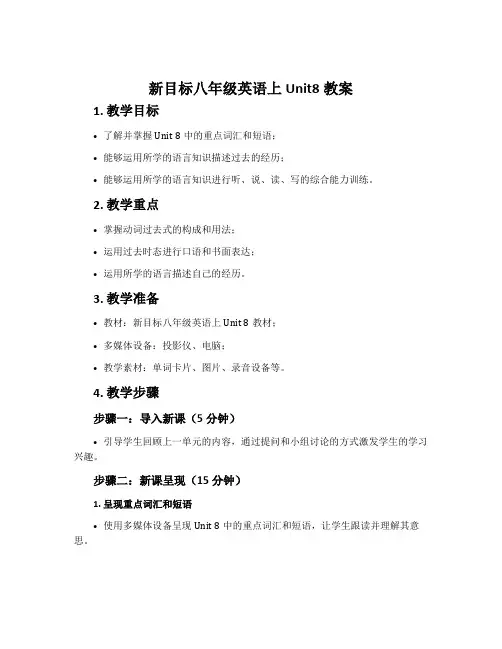
新目标八年级英语上Unit8教案1. 教学目标•了解并掌握Unit 8中的重点词汇和短语;•能够运用所学的语言知识描述过去的经历;•能够运用所学的语言知识进行听、说、读、写的综合能力训练。
2. 教学重点•掌握动词过去式的构成和用法;•运用过去时态进行口语和书面表达;•运用所学的语言描述自己的经历。
3. 教学准备•教材:新目标八年级英语上Unit 8教材;•多媒体设备:投影仪、电脑;•教学素材:单词卡片、图片、录音设备等。
4. 教学步骤步骤一:导入新课(5分钟)•引导学生回顾上一单元的内容,通过提问和小组讨论的方式激发学生的学习兴趣。
步骤二:新课呈现(15分钟)1. 呈现重点词汇和短语•使用多媒体设备呈现Unit 8中的重点词汇和短语,让学生跟读并理解其意思。
2. 引入过去时态•通过给出一段关于自己经历的简短故事,引入过去时态的概念,并解释过去时态的构成和用法。
步骤三:教学练习(25分钟)1. 听说训练•让学生跟随录音回答关于过去经历的问题,提高学生的听说能力。
2. 阅读训练•让学生阅读课文并完成相关的阅读练习,培养学生的阅读理解能力。
3. 写作训练•让学生根据提供的写作指导,写一篇关于自己的过去经历的短文。
通过写作训练,提高学生的写作能力和叙述能力。
步骤四:课堂练习(20分钟)•在教材中选择相关练习题,组织学生进行个人、小组或全班的课堂练习。
步骤五:作业布置(5分钟)•布置相关阅读和写作作业,要求学生在家完成并在下节课交给老师检查。
5. 教学延伸•鼓励学生使用过去时态描述自己的经历,引导学生讨论并分享自己的经历,提高学生口语表达能力。
6. 教学反思本节课通过多种教学方法和形式,使学生在听、说、读、写的各个方面都得到了锻炼和提高。
课堂上设置了许多练习,能够帮助学生巩固所学的知识点,并且在动态的交流中,学生的学习主动性得到了调动。
本节课通过灵活运用教学手段,培养了学生的英语综合能力,并且通过个别辅导和点拨,使学生在应用所学知识的过程中建立信心,更好地完成课堂任务。
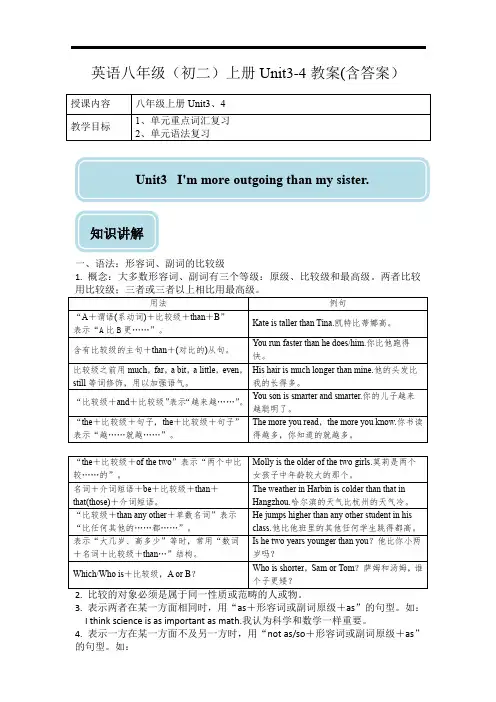
英语八年级(初二)上册Unit3-4教案(含答案)Unit3 I'm more outgoing than my sister.知识讲解一、语法:形容词、副词的比较级1. 概念:大多数形容词、副词有三个等级:原级、比较级和最高级。
两者比较3. 表示两者在某一方面相同时,用“as+形容词或副词原级+as”的句型。
如:I think science is as important as math.我认为科学和数学一样重要。
4. 表示一方在某一方面不及另一方时,用“not as/so+形容词或副词原级+as”的句型。
如:It is not as/so warm today as yesterday.今天不如昨天暖和。
二、辨析1. be like“就像…”I am like your sister.look like “外貌上的像”I look like my sister.2.both…and…两者都,后面的动词用复数形式Both Tom and Jim are students.3.help sb. to (do) sth. 帮助某人做某事= help sb. with sth. 在某方面帮助某人He often helps me (to)learn English. 他经常帮助我学习英语。
= He often helps me with my English. 他经常在英语方面帮助我。
4. That’s why+句子:那就是…的原因/那就是为什么…That's why I study English hard. 那就是我努力学习英语的原因。
三、短语1. more outgoing 更外向/更开朗2 make friends with sb. 与某人交朋友3. the singing competition 歌咏比赛4. the most important 最重要的5. be talented in music 在音乐方面有天赋6. the same as 与……相同be similar to 与…相似7. care about 关心/留意/关注8. be different from 与…...不同9. be like a mirror 像一面镜子10. as long as 只要;与…...一样长11. bring out 显示/显出12. have fun=Have a good time 玩得开心have fun doing sth 做某事很开心13. reach for 伸手达到/达到14. touch one’s heart 感动15. in fact 事实上16. the other 另一个17. be good with 与…和睦相处同步练习一、根据句意及汉语提示填写单词。
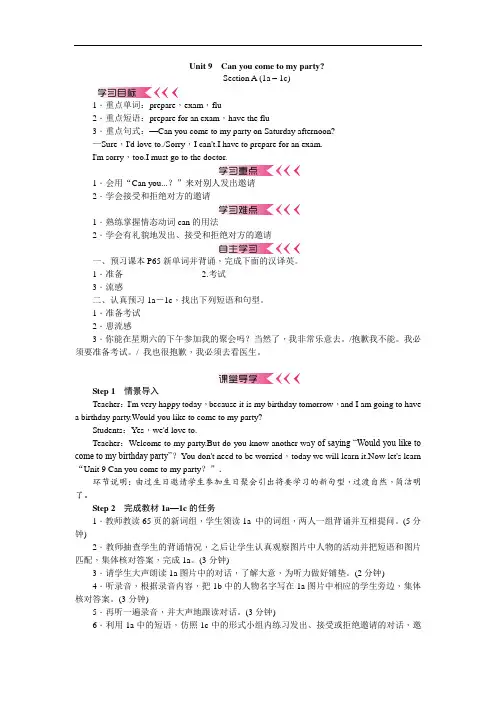
Unit 9Can you come to my party?Section A (1a-1c)1.重点单词:prepare,exam,flu2.重点短语:prepare for an exam,have the flu3.重点句式:—Can you come to my party on Saturday afternoon?—Sure,I'd love to./Sorry,I can't.I have to prepare for an exam.I'm sorry,too.I must go to the doctor.1.会用“Can you...?”来对别人发出邀请2.学会接受和拒绝对方的邀请1.熟练掌握情态动词can的用法2.学会有礼貌地发出、接受和拒绝对方的邀请一、预习课本P65新单词并背诵,完成下面的汉译英。
1.准备____________ 2.考试____________3.流感____________二、认真预习1a-1c,找出下列短语和句型。
1.准备考试____________________2.患流感____________________3.你能在星期六的下午参加我的聚会吗?当然了,我非常乐意去。
/抱歉我不能。
我必须要准备考试。
/ 我也很抱歉,我必须去看医生。
________________________________________________________________________Step 1情景导入Teacher:I'm very happy today,because it is my birthday tomorrow,and I am going to have a birthday party.Would you like to come to my party?Students:Yes,we'd love to.Teacher:Welcome to my party.But do you know another wa y of saying “Would you like to come to my birthday party”?You don't need to be worried,today we will learn it.Now let's learn “Unit 9 Can you come to my party?”.环节说明:由过生日邀请学生参加生日聚会引出将要学习的新句型,过渡自然,简洁明了。
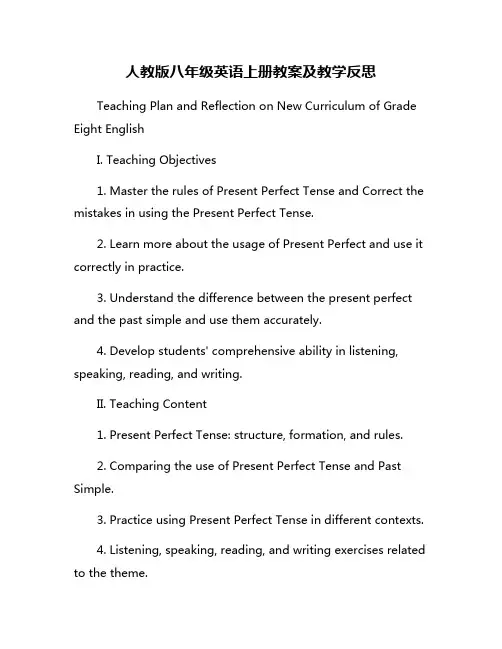
人教版八年级英语上册教案及教学反思Teaching Plan and Reflection on New Curriculum of Grade Eight EnglishI. Teaching Objectives1. Master the rules of Present Perfect Tense and Correct the mistakes in using the Present Perfect Tense.2. Learn more about the usage of Present Perfect and use it correctly in practice.3. Understand the difference between the present perfect and the past simple and use them accurately.4. Develop students' comprehensive ability in listening, speaking, reading, and writing.II. Teaching Content1. Present Perfect Tense: structure, formation, and rules.2. Comparing the use of Present Perfect Tense and Past Simple.3. Practice using Present Perfect Tense in different contexts.4. Listening, speaking, reading, and writing exercises related to the theme.III. Teaching Procedures1. Warm-up (10 minutes)- Review the Present Perfect Tense with some examples.- Introduce the learning objectives for today.- Play a short video or audio clip using the Present Perfect Tense for students to listen and repeat.2. Presentation (20 minutes)- Present the rules and formation of the Present Perfect Tense with examples.- Explain the difference between the Present Perfect Tense and the Past Simple Tense.- Provide exercises for students to practice forming sentences using the Present Perfect Tense.3. Practice (30 minutes)- Divide students into pairs or small groups and give them exercises to complete.- Monitor and provide feedback as students work on the exercises.- Have students share their answers and correct mistakes together.4. Application (20 minutes)- Play a listening comprehension activity using the Present Perfect Tense for students to practice listening skills.- Have students discuss in pairs or groups using the Present Perfect Tense.- Assign homework that includes writing exercises using the Present Perfect Tense.IV. ReflectionThis teaching plan focused on teaching students the Present Perfect Tense and helping them understand the difference between the present perfect and past simple. The warm-up activity was effective in engaging students and setting the tone for the lesson. The presentation was clear, and students were able to grasp the rules and formation of the Present Perfect Tense easily. The practice activities provided students with opportunities to apply what they learned, and the application activities allowed them to practice their listening, speaking, and writing skills.However, there were some challenges during the lesson. Some students struggled with forming sentences using the Present Perfect Tense correctly, especially when distinguishing it from the past simple. In the future, I would incorporate more interactive and hands-on activities to reinforce the concept of the Present Perfect Tense. I would also provide additional examples and exercises to help students practice and master the usage of the Present Perfect Tense.Overall, this teaching plan was successful in achieving its objectives and helping students improve their English language skills. With some adjustments and improvements, I believe it can be even more effective in future lessons.。
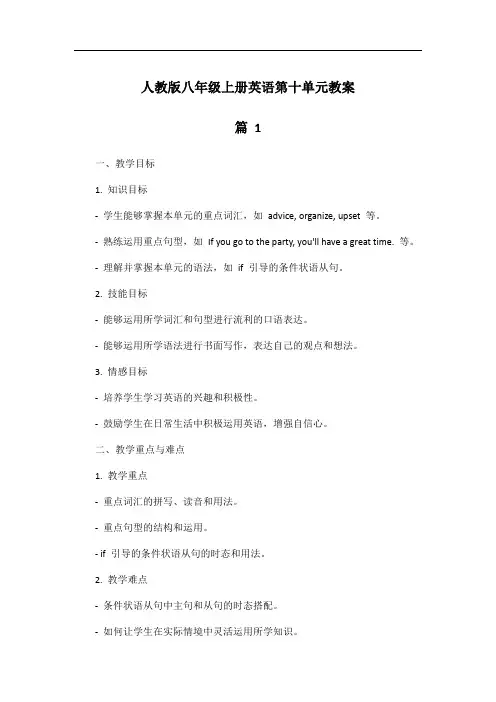
人教版八年级上册英语第十单元教案篇 1一、教学目标1. 知识目标-学生能够掌握本单元的重点词汇,如advice, organize, upset 等。
-熟练运用重点句型,如If you go to the party, you'll have a great time. 等。
-理解并掌握本单元的语法,如if 引导的条件状语从句。
2. 技能目标-能够运用所学词汇和句型进行流利的口语表达。
-能够运用所学语法进行书面写作,表达自己的观点和想法。
3. 情感目标-培养学生学习英语的兴趣和积极性。
-鼓励学生在日常生活中积极运用英语,增强自信心。
二、教学重点与难点1. 教学重点-重点词汇的拼写、读音和用法。
-重点句型的结构和运用。
- if 引导的条件状语从句的时态和用法。
2. 教学难点-条件状语从句中主句和从句的时态搭配。
-如何让学生在实际情境中灵活运用所学知识。
三、教学方法1. 情景教学法-创设与单元主题相关的情境,如聚会、旅行等,让学生在真实的场景中感受和理解语言的运用。
2. 任务驱动法-布置各种任务,如对话编写、短文写作等,让学生在完成任务的过程中巩固所学知识。
四、教学过程(一)导入1. 教师:“同学们,咱们先来看一段关于聚会的小视频。
”(播放视频)2. 教师:“视频里的聚会是不是很有趣呀?那今天咱们就来学习跟聚会有关的英语知识。
”(二)词汇学习1. 教师呈现本单元的重点词汇,如advice, organize, upset 等,带领学生读几遍,纠正发音。
2. 教师:“同学们,咱们来看这个单词‘advice’,它是不可数名词哦,比如‘some advice’。
那‘give advice’是什么意思呢?谁来说说?”(引导学生回答)3. 教师通过举例、造句等方式帮助学生理解词汇的用法。
(三)句型学习1. 教师呈现重点句型“If you go to the party, you'll have a great time.”,讲解句型结构和用法。

有关八年级英语教案人教版5篇八班级英语教案人教版精选篇1本节课讲授的内容是仁爱版教材八班级英语(上册)第三单元Topic I Section A。
这一单元描述hobbies,每个话题基本上与同学日常生活息息相关的内容。
第一话题I love collecting stamps 不单是谈论有关集邮方面的爱好,还有听音乐、做运动等。
这极大地丰富了同学们的业余生活,通过谈论彼此的爱好爱好,既学到了学问,又加深了师生之间的感情。
一、指导思想:从新课标的理念动身,贯彻面对全体同学,以同学的终身进展为本的指导思想。
对原教材内容重新加以处理。
力求对教学过程细心设计,接受任务型教学途径,全方位调动同学学习英语的乐观性,培育他们的综合语言运用力气。
二、教学目标1、学问与技能目标:①学会关于爱好、爱好方面的词汇②能够运用语言谈论自个儿及他人的爱好和爱好。
2、情感目标:有爱好听英语、讲英语、唱歌曲、做玩耍,乐于仿照,敢于开口,乐观参与,团结协作。
3、学习策略目标:能热忱地与他人合作。
共同完成学习任务;主动向老师和同学请教;留意力集中;乐观地运用所学英语进行表达和交际。
三、教学重点及难点1、教学重点:同学能够运用各种方式谈论爱好、爱好、并初步熟识感叹句2、教学难点:used to的用法四、教学过程1、课前热身,师生同唱一首歌:(调动同学的乐观性,拉近师生的距离)2、复习love,like,prefer,enjoy+v-ing结构,为新课作预备①老师简介家人的爱好爱好My sister likes dancing,but she doesn`t love singing,My brother enjoys skating.He also prefers swimming②师生对话谈论宠爱做的状况,反复应用What do you lovelikeenjoyprefer doing?巩固用法,增进师生间了解.3、导入:依照对话内容,老师表达Swimming is A’s hobby.Singing is B’s hobby. Reading is my hobby.老师拿出部分收集的邮票,边让同学看,边表达,Collecting stamps is my hobby, too. I love collecting stamps.导入Topic 1标题。
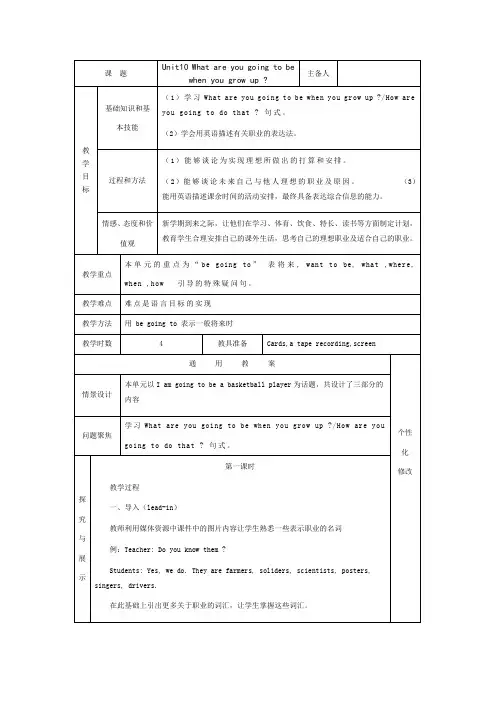
any plan for the new term? First write down your resolutions. Then read your resolutions to your partners and talk about them.
a. 新学期到来之际,让学生在学习、体育、饮食、特长、读书等方面制定计划,并在小组内讨论。
b. 每组选派一名同学到其他组采访,了解他们的新学期的打算,并记录在以下的表格中。
c. 各组选派的同学向组员汇报采访结果。
d. 汇总各组采访结果并总结全班同学的新学期打算。
e. 让学生谈谈上学期的计划及计划完成情况。
教师提示可能用到的语言:I’m going to………
,完成1b的训练。
仿照句型和同桌进行口语对话练习。
三、教学SectionB -2a,2b
1.要求学生快速阅读 2a ,2b,帮助学生明确听力语言目标的要求。
2.听两遍,完成2a ,2b,中的问题。
3.第三遍分发听力材料, 教师订正答案,并强调一些读音规则,帮助学生更容易听懂听力材料。
四、教学SectionB -2c
在做对话时,要求学生除使用本课目标语言want to be/going to be ,还要做出几个Wh问句及其回答,然后小组交流,互相补充。
例如:A: What are you going to do in the future?
B:I want to be a teacher. I’m going to get good grades.。
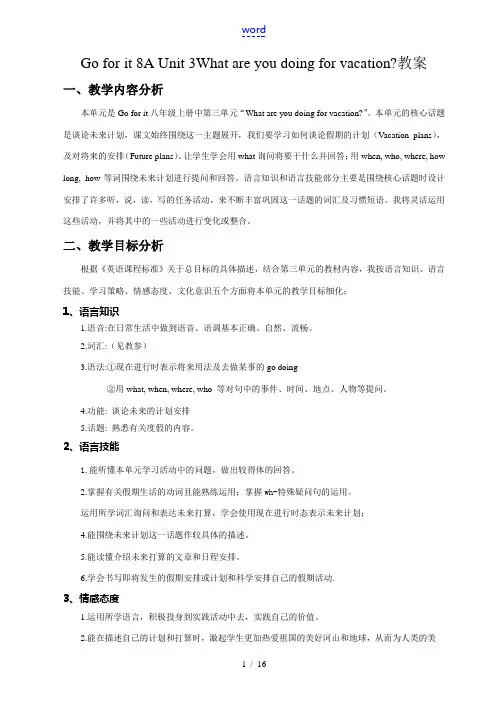
Go for it 8A Unit 3What are you doing for vacation?教案一、教学内容分析本单元是Go for it八年级上册中第三单元“What are you doing for vacation?”。
本单元的核心话题是谈论未来计划,课文始终围绕这一主题展开,我们要学习如何谈论假期的计划(Vacation plans),及对将来的安排(Future plans)。
让学生学会用what询问将要干什么并回答;用when, who, where, how long, how等词围绕未来计划进行提问和回答。
语言知识和语言技能部分主要是围绕核心话题时设计安排了许多听,说,读,写的任务活动,来不断丰富巩固这一话题的词汇及习惯短语。
我将灵活运用这些活动,并将其中的一些活动进行变化或整合。
二、教学目标分析根据《英语课程标准》关于总目标的具体描述,结合第三单元的教材内容,我按语言知识、语言技能、学习策略、情感态度、文化意识五个方面将本单元的教学目标细化:1、语言知识1.语音:在日常生活中做到语音、语调基本正确、自然、流畅。
2.词汇:(见教参)3.语法:①现在进行时表示将来用法及去做某事的go doing②用what, when, where, who 等对句中的事件、时间、地点、人物等提问。
4.功能: 谈论未来的计划安排5.话题: 熟悉有关度假的内容。
2、语言技能1.能听懂本单元学习活动中的问题,做出较得体的回答。
2.掌握有关假期生活的动词且能熟练运用;掌握wh-特殊疑问句的运用。
运用所学词汇询问和表达未来打算,学会使用现在进行时态表示未来计划;4.能围绕未来计划这一话题作较具体的描述。
5.能读懂介绍未来打算的文章和日程安排。
6.学会书写即将发生的假期安排或计划和科学安排自己的假期活动.3、情感态度1.运用所学语言,积极投身到实践活动中去,实践自己的价值。
2.能在描述自己的计划和打算时,激起学生更加热爱祖国的美好河山和地球,从而为人类的美好明天贡献自己的一份力量。
初中英语人教版八年级上册英语教案篇1一、教学目标1. 学生能够掌握课本中的重点词汇和短语,如“be interested in”“take part in”等,并且能够正确运用它们进行造句。
2. 学生能够理解并熟练运用课本中的重点句型,例如“What are you going to do this weekend?”“I'm going to...”等,进行日常交流。
3. 学生通过阅读课文,能够提高阅读理解能力,理解文章的主旨大意和细节信息。
4. 培养学生的听说读写综合能力,让学生在英语学习中更加自信和积极。
二、教学重点与难点重点:1. 重点词汇和短语的掌握与运用。
2. 重点句型的理解和运用。
难点:1. 一些复杂句子的理解,比如含有宾语从句的句子。
2. 如何让学生在实际情境中自然地运用所学知识进行交流。
三、教学方法1. 情景教学法:通过创设各种真实的生活场景,让学生在情境中学习和运用英语。
比如,设置一个周末活动的场景,让学生用所学句型讨论自己的周末计划。
2. 任务驱动法:给学生布置具体的任务,让他们在完成任务的过程中学习英语。
比如,让学生分组制作一份英语手抄报,介绍自己喜欢的活动。
3. 多媒体教学法:利用图片、视频等多媒体资源,激发学生的学习兴趣,帮助他们更好地理解教学内容。
比如,播放一段英语电影片段,让学生从中找出所学的词汇和句型。
四、教学过程(一)导入上课铃响了,同学们都陆续回到座位上。
老师微笑着走进教室,对同学们说:“嘿,孩子们,今天咱们先来看个好玩的视频咋样?”同学们一听,立刻来了精神。
老师打开多媒体设备,播放了一段有趣的英语短视频。
视频里有可爱的小动物们用英语对话,还有欢快的音乐。
同学们看得津津有味,时不时发出笑声。
视频播放完后,老师问:“咋样呀,同学们?这个视频有趣不?”同学们纷纷点头。
老师接着说:“那你们在视频里听到了哪些英语单词呀?”同学们七嘴八舌地回答起来。
老师把同学们说的单词写在黑板上,然后说:“今天呀,咱们就来学习这些单词和相关的英语知识。
八年级上册英语第一单元教案教学是需要教案的,下面是为各位老师整理推荐的八年级上册英语第一单元教案,欢迎各位借鉴。
八年级上册英语第一单元教案【1】一、教学目标:1.语言知识目标:1)能掌握以下单词:anyone,anywhere,wonderful,quiteafew,most,something,nothing, everyone,ofcourse,myself,yourself能掌握以下句型:①—Wheredidyougoonvacation?—Iwenttothemountains.②—WheredidTinatoonvacation?—Shewenttothebeach.③—Didyougowithanyone?—Yes,Idid./No,Ididn’t.2)能了解以下语法:—复合不定代词someone,anyone,something,anything等的用法。
—yourself,myself等反身代词的用法。
3)一般过去时态的特殊疑问句,一般疑问句及其肯定、否定回答。
2.情感态度价值观目标:学会用一般过去时进行信息交流,培养学生的环保意识,热爱大自然。
二、教学重难点1.教学重点:1)用所学的功能语言交流假期去了什么旅行。
2)掌握本课时出现的新词汇。
2.教学难点:1)复合不定代词someone,anyone,something,anything等的'用法。
2)yourself,myself等反身代词的用法。
三、教学过程Ⅰ.Lead-in1.看动画片来进入本课时的主题谈论上周末做了些什么事情,谈论过去发生的事情。
Ⅱ.Presentation1.Showsomepicturesonthebigscreen.LetSsreadtheexpressio ns.2.Focusattentiononthepicture.Ask:Whatcanyousee?Say:Each pictureshowseachactivityandaskstudent storepeat:Stayedathome,Wenttomountains,wenttoNewYorkCity6.Wen ttothebeach,visitedmyuncle,visitedmuseums,wenttosummercam p3.Now,pleasematcheachphrasewithoneofthepicturesnexttot henameofthe activity,pointtothesampleanswer.4.Checktheanswers.Answers:1.f2.b3.g4.e5.c6.a7.d八年级上册英语第一单元教案【2】一、教学目标:1.语言知识目标:1)能掌握以下单词:anyone,anywhere,wonderful,quiteafew,most,something,nothing, everyone,ofcourse,myself,yourself能掌握以下句型:①—Wheredidyougoonvacation?—Iwenttothemountains.②—WheredidTinatoonvacation?—Shewenttothebeach.③—Didyougowithanyone?—Yes,Idid./No,Ididn’t.2)能了解以下语法:—复合不定代词someone,anyone,something,anything等的用法。
八年级英语上册复习教案第一章:Unit 1 How often do you exercise?1.1 教学目标掌握频率副词和一般现在时的肯定句及疑问句的构成。
学会用一般现在时谈论日常习惯和频率副词。
能正确回答关于日常习惯的一般现在时疑问句。
1.2 教学内容频率副词:always, usually, often, sometimes, rarely, never.一般现在时的肯定句:Subject + verb(s/es) + other words.一般现在时的疑问句:Do/Does/Did + Subject + verb(s/es) + other words?1.3 教学活动复习频率副词和一般现在时的肯定句。
学生互相提问关于日常习惯的一般现在时疑问句,并回答。
老师给出一些日常习惯的句子,学生判断句子是否使用了一般现在时。
第二章:Unit 2 Do you like pop music?2.1 教学目标掌握形容词最高级的构成和用法。
学会用形容词最高级描述音乐、电影等喜好。
2.2 教学内容形容词最高级的构成:adjective + -est + other words.形容词最高级的疑问句:Which + noun + adjective(最高级) + other words?2.3 教学活动复习形容词最高级的构成和用法。
第三章:Unit 3 Could you please write slower?3.1 教学目标掌握情态动词could的用法。
学会用情态动词could提出请求或建议。
能正确回答关于请求或建议的情态动词could疑问句。
3.2 教学内容情态动词could的用法:用来提出请求、建议或可能性。
情态动词could的肯定句:Subject + could + verb + other words. 情态动词could的疑问句:Could + Subject + verb + other words?3.3 教学活动复习情态动词could的用法。
Unit1 SectionB(3a-Self Check)全英版教案Teaching Aims1. Knowledge objects(1)Function:Use “Past tense” to talk about the places where you went on vacation.(2)Key V ocabulary:Tian’anmen Square, the Palace Museum.(3)Target Language:①I felt really tired.②I went to buy something special.③How did you feel about the trip?(4) Structure:indefinite+ adj.2. Ability ObjectsDevelop the abilities to write a travel diary.3. Moral ObjectsShare one’s mood about a vacation with the friends.Teaching Key PointsIrregular verbs and regular verbs.Teaching Difficult PointsWriting a travel diary.Teaching MethodsSituation teaching method.Teaching Aids1. Some pictures of beautiful view which we visited.2. A tape recorder.Teaching ProceduresStep 1 Greeting and Checking the homework (about 6 minutes)The teacher can find some students read their articles or check all of them before the class, then the teacher point the mistakes on the blackboard. (Attention: students may make many mistakes on how to use irregular verbs, so we should give the students three minutes to correct the mistakes.)Step 2 3a (about 6 minutes)Complete the diary entry about a trip to one of these places. Use the words and phrases in the box to help you.The first blank:the date.The second blank:the weather.The third blank:the place.The fourth blank:the description about the place.The fifthblank:the activities.From the sixth to the last blank:the feelings.Step 3 3b (about 8 minutes)Ask students to answer the question one by one.Begin with an easy question.T:Didyou go to any interesting placevacation?S1:Yes, I did.T:Where did you go?S2:I went to the Palace Museum in Beijing.T:Did you go with anyone?S3:Yes, I went with my parents.T: How was the weather?S4:The weather was hot and sunny.T:What did you do every day?S5: We visited the museum and bought something interesting.T:What food did you eat?S6:Beijing Duck. It was delicious.T:What did you like best?S7:The Palace Museum.T:Did you dislike anything?S8:No. I think everything was interesting.T:How did you feel about the trip?S9:It’s wonderful!Objects:The content of a travel diary.Attention:The students can answer the questions according to their own situations.Step 4 3c (about 10 minutes)T:Write a travel diary like Jane’s on the text book. Use your notes in 3b. Pay attention to the irregular verbs in past tense. It should include the eight questions in 3b, but you can add some sentences.Let two students write on the blackboard.(Check other students^ writing, and summarize the mistakes. Then teach the students how to correct them on the blackboard.)Step 5 4 (about 7 minutes)Make conversations according to page 8. (askand answer)A:Hi, my name’s Paul.B:Hi, Paul. I am Anna, Where did you go onvacation?A:I went to Nanjing.B:Oh, I went to Beijing, Did you do anything special in Nanjing?Encourage the students to do the conversation in pairs, and give them two minutes to prepare it.Use five minutes for the students to show their conversations.Step 6 Self Check (about 5 minutes)Complete the conversations with the correct words in the box.These are indefinite pronouns, the teacher should lead students to go over indefinite pronouns. Pay attention to “some…any…”1. Pay attention to” some …—any...”2. Complete the passage with the correct forms of the verbs. (Pay attention to the irregular verbs.)Step 7 Summary (about 2 minutes)T : In this class, we learned how to write a travel diary. In the diary we should use past tense. So it is important for us to turn a verb to its past tense form. We divided the verb into two parts, regular verbs (e.g.:work—worked, live—lived, stop—stopped, study—studied,...)and irregular verbs.(e. g.:make—made, swim—swam …)Step 8 Homework (about 1 minute)Write a travel diary.T:You should write when (when you have the trip), what (what activities you do ), who(who you go with ), how (how you feel about the travel) and so on. 70 words at least.Blackboard DesignUnit 1 Where did you go on vacation?The Fourth Period (Section B 3a—Self Check)一:动词过去时规则变化1. 直接加ed: clean—cleaned2. 以不发音的e结尾的, +d:love—loved3. 以辅音字母+y结尾的, 变y为i加ed:study—studied4. 以重读闭音节结尾的, 双写最后的辅音字母+ed:plan—planned二:不规则变化1. 不变型:cut—cut, let—let, put—put, read—read2. 加t、加d 型或变t/d 型:mean—meant, hear— heard, make—made3. t变d 型:send—sent, spend—spent4. i变a 型:swim—swam, sing—sang, begin—began...5.其他情况。
初二英语教案6篇初二英语教案1一、说教材1.教材分析:本单元的标题为What’s the matter?主要学习如何表述身体的种.种不适以及给出恰当的建议。
本节课的上课内容是section B 1a-2c主要是对前面学习过的内容进行复习和扩展,主要复习的句型是What’s the matter? What should he / she / it do?同时,教材通过练习让学生学习新单词,并能用所学的新单词去说,从而达到学以致用的效果。
2.教学目标语言知识目标:学习并掌握句型:What’s the matter?学习情态动词should/ shouldn’t的用法能够对健康问题提出相应的建议,如:You should ……语言技能目标:能听懂谈论健康问题的对话材料:What’s the matter?能对别人的健康问题提出建议:(a)You should drink some water.(b)You shouldn’t eat anything.情感态度目标:通过谈论健康问题,培养学生关心他人身体健康的爱心二、教法与学法根据本节课教材特点以及八年级学生年龄的特点,采取任务型教学法,而学生也相应地采取自主、合作、探究的学习方式。
在课堂中利用多媒体课件来展开课堂Pair work的口语交际活动,让学生参与其中。
在教学中,尽量让学生能主动的参与到问题的讨论中,充分调动学生学习的积极性和主动性,使学生在参与过程中学到知识。
三、学情分析学生已经积累了一定的词汇,并熟练掌握了一些句型。
他们现在最感兴趣的是能用所学的英语来表述一些和现实生活息息相关的话题,并给出合理的解决办法。
本单元通过表述身体的各种不适和谈论个人健康问题,使学生学会关心他人身体健康,并能提出一些建议。
四、教学重难点1.教学重点掌握身体各部位的表达法和健康问题的表达法;掌握情态动词should/shouldn’t的用法重点词汇:tired, hungry, thirsty, be stressed out重点句型:What’s the matter?You should/ shouldn’t….2.教学难点情态动词should/ shouldn’t的用法短语:go to bed early, be stressed out, listen to music五、课堂教学设计1.导入:通过刘翔引入句型:What’s the matter with him?通过最近发生的事情引起学生的兴趣。
八年级上册英语教学设计(全册)一Unit1 Where did you go on vacation教学设计Unit 2 How often do you exercise?教学设计(单元教案)Unit3 I’m more outgoing than my sister单元教案Step 3. Section B1aStep 4. Gro upw orkStep 5. Listen ing. T: All of you have good friends,right? Well , Can you tell me thesame and di fference betweenyou and your friends?S1: He is quiter than me.S2: We are both tall.S3: Her hair is longer than mine.T: Great! And what do you thinkthe most important things are tobe your friends?Statements your friends usingthe phrases in 1a.In this activity, first ask thestudents to look at the names andthe first column of the table.Tell students they will hear abinterviewer talking to Molly andMary. They are t alking about whatthey like about their best friends.SpeakingGroupworkListening主题内容。
小组操练,培养集体协作能力。
以便学生能抓住其精髓。
教学环节教学活动设计意图教师活动学生活动Step6 Discussion Step 7. Home work 1 Who would you like to makefriends with? (Ron, Hermoine,or Harry Porter) Why?2 Introduce your new friend to usWrite five statements about w hatis important in a friend.Discussion本部分的讨论活动是对前面片段的总结, 主要目的是激发学生用所学的句子结构发表自己的意见板书设计Unit3 I’m more outgoing than my sister..has cool clothesis popular in school.likes to do the same things as me. ( has the same interests)is good at sports ( athletic)is good at schoolwork.makes me laugh. ( funny)教学反思英语教学提倡体验、实践、参与、交流与合作的学习方式,要使学生尽可能亲身感受和直接体验语言A goodfriend。
Unit 9: How was your weekend?
1.Teaching aims and demands:
1.Learn to discuss what do they do on the weekends.
2.Learn the usage of the past tense.
2.Teaching procedure:
Step 1 Review
1.Review the rugular and irregular verbs about the past tense.
2.Ask the students"What did they do last weekend".
Step 2 Presentation
1.Let the students pay attention to the four pictures,ask them to point to
and use the past tense to describe as many of the activities as possible.
2.Point to the numbered activities of described in the list.Name the
activities and ask students to repeat each one.
3.Ask the students to match each numbered phrase with a picture.
4.Point out and draw a happy face or an unhappy face under the pictures in 1a.
Step 3 Consolidation
1.Call attention to 2a,play the recording the first time.
Students only listen.
2.Point out the sample answer, cleaned her room.
3.Play the recording again.Ask students to fill in the phrases telling what
each person did.
4.Check the answers.
Step 4 Practice
1.Call attention to the example in speech bubbles.A student and me will read
it to the class.
2.Practice talking about what Jim and Sally did last weekend in pairs,and say
a conversation about what you did over the weekend.
3.Ask some pairs to present their conversations to the class.
4.If time is enough,let the students to make conversations with teachers at
the back.